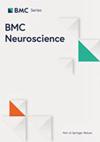髓鞘少突胶质细胞糖蛋白诱导的实验性自身免疫性脑炎小鼠聚(乳酸)乙二醇干预剂的给药方法和剂量
IF 2.4
4区 医学
Q3 NEUROSCIENCES
引用次数: 0
摘要
髓鞘少突胶质细胞糖蛋白相关疾病(MOGAD)是一种自身免疫性中枢神经系统疾病。最近,使用聚乳酸共聚乙醇酸(PLGA)等纳米颗粒的抗原特异性免疫耐受被用作中枢神经系统自身免疫性疾病的一种新的治疗耐受方法。我们研究了在实验性自身免疫性脑炎(EAE)小鼠模型中,MOG1-125与PLGA共轭能否诱导MOG特异性免疫耐受。使用 MOG1-125 肽和完全弗氏佐剂诱导 60 只 C57BL/6 J 野生型小鼠发生 EAE。小鼠被分成12组(每组5只),与单独使用抗原或单独使用PLGA相比,测试MOG1-125共轭PLGA干预在使用或不使用雷帕霉素的情况下减轻EAE严重程度或改善EAE结果的能力。EAE评分和血清MOG-IgG滴度在干预措施之间进行了比较。Kindly check and confirm the processed Affiliation “4” is appropriate.I confirmed the Affiliation 4.Affiliation.请检查并确认所处理的Affiliation“4”是否合适:通讯作者信息已更改为现工作单位。Kindly check and confirm.我检查并确认了通讯作者的信息。EAE小鼠腹腔注射MOG1-125共轭PLGA+雷帕霉素复合物后,EAE评分呈剂量依赖性减轻。腹腔注射和静脉注射的临床结果相似,而皮下注射治疗的小鼠有80%在约1周后临床评分再次恶化。虽然未结合PLGA和结合MOG的PLGA在EAE评分上没有明显差异,但与对照组相比,结合MOG的PLGA组的血清MOG-IgG呈下降趋势。与皮下注射相比,腹腔注射 PLGA 可产生剂量依赖性和更持久的免疫耐受。使用PLGA诱导免疫耐受可能是未来治疗MOGAD患者的一种选择。本文章由计算机程序翻译,如有差异,请以英文原文为准。
Administration methods and dosage of poly(lactic acid)-glycol intervention to myelin oligodendrocyte glycoprotein-induced experimental autoimmune encephalitis mice
Myelin oligodendrocyte glycoprotein-associated disorders (MOGAD) is an autoimmune central nervous system disease. Antigen-specific immune tolerance using nanoparticles such as Polylactic-co-glycolic acid (PLGA) have recently been used as a new therapeutic tolerization approach for CNS autoimmune diseases. We examined whether MOG1-125 conjugated with PLGA could induce MOG-specific immune tolerance in an experimental autoimmune encephalitis (EAE) mouse model. EAE was induced in sixty C57BL/6 J wild-type mice using MOG1-125 peptide with complete Freund’s Adjuvant. The mice were divided into 12 groups (n = 5 each) to test the ability of MOG1-125 conjugated PLGA intervention to mitigate the severity or improve the outcomes from EAE with and without rapamycin compared to antigen alone or PLGA alone. EAE score and serum MOG-IgG titers were compared among the interventions.Kindly check and confirm the processed Affiliation “4” is appropriate.I confirmed the Aff 4.Affiliation: Corresponding author information have been changed to present affiliation. Kindly check and confirm.I checked and confirmed the Corresponding author's information. Mice with EAE that were injected intraperitoneally with MOG1-125 conjugated PLGA + rapamycin complex showed dose-dependent mitigation of EAE score. Intraperitoneal and intravenous administration resulted in similar clinical outcomes, whereas 80% of mice treated with subcutaneous injection had a recurrence of clinical score worsening after approximately 1 week. Although there was no significant difference in EAE scores between unconjugated-PLGA and MOG-conjugated PLGA, serum MOG-IgG tended to decrease in the MOG-conjugated PLGA group compared to controls. Intraperitoneal administration of PLGA resulted in dose-dependent and longer-lasting immune tolerance than subcutaneous administration. The induction of immune tolerance using PLGA may represent a future therapeutic option for patients with MOGAD.
求助全文
通过发布文献求助,成功后即可免费获取论文全文。
去求助
来源期刊

BMC Neuroscience
医学-神经科学
CiteScore
3.90
自引率
0.00%
发文量
64
审稿时长
16 months
期刊介绍:
BMC Neuroscience is an open access, peer-reviewed journal that considers articles on all aspects of neuroscience, welcoming studies that provide insight into the molecular, cellular, developmental, genetic and genomic, systems, network, cognitive and behavioral aspects of nervous system function in both health and disease. Both experimental and theoretical studies are within scope, as are studies that describe methodological approaches to monitoring or manipulating nervous system function.
 求助内容:
求助内容: 应助结果提醒方式:
应助结果提醒方式:


